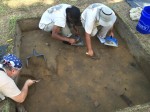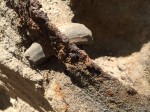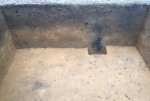 Archaeologists returned to the site of the first multi-year settlement in the United States this summer and discovered more 16th century artifacts. Discovered by a local historian almost a year ago in Pensacola, Florida, the Santa Maria de Ochuse settlement was founded by Don Tristán de Luna y Arellano in August 1559. The 1,500 colonists — Spanish soldiers, indigenous Mexicans and African slaves — would have been well-provisioned has six of their 11 ships not been destroyed by a hurricane a month after their arrival. They wound up having to make do on their own which did not go well. In 1561, the survivors were picked up by Spanish ships and there was no further attempt at settlement of what would become the United States until Pedro Menéndez founded the St. Augustine colony in 1565.
Archaeologists returned to the site of the first multi-year settlement in the United States this summer and discovered more 16th century artifacts. Discovered by a local historian almost a year ago in Pensacola, Florida, the Santa Maria de Ochuse settlement was founded by Don Tristán de Luna y Arellano in August 1559. The 1,500 colonists — Spanish soldiers, indigenous Mexicans and African slaves — would have been well-provisioned has six of their 11 ships not been destroyed by a hurricane a month after their arrival. They wound up having to make do on their own which did not go well. In 1561, the survivors were picked up by Spanish ships and there was no further attempt at settlement of what would become the United States until Pedro Menéndez founded the St. Augustine colony in 1565.
 The settlement site was excavated this season by archaeologists and students of the University of West Florida Archaeology Summer Field School. The team focused on the center and perimeter of the settlement, and what they’ve discovered aligns very well with primary documents about the expedition found in Spain by UWF archaeologist Dr. John Worth. One find that would warm the heart of any archaeologist is a trash pit, a stuffed one at that. The pit contains food detritus — seafood like shellfish, oysters and scallops — and a deer antler that suggests the would-be colonists supplemented their fishing with hunting. The team also found a number of iron strap fragments that were probably the hoops from barrels. Once the barrels were empty of the supplies they carried, archaeologists believe, Luna’s people may have broken them up and put them to practical use, like in the forging of nails, for example, or to make goods to trade with the local Native American population for food.
The settlement site was excavated this season by archaeologists and students of the University of West Florida Archaeology Summer Field School. The team focused on the center and perimeter of the settlement, and what they’ve discovered aligns very well with primary documents about the expedition found in Spain by UWF archaeologist Dr. John Worth. One find that would warm the heart of any archaeologist is a trash pit, a stuffed one at that. The pit contains food detritus — seafood like shellfish, oysters and scallops — and a deer antler that suggests the would-be colonists supplemented their fishing with hunting. The team also found a number of iron strap fragments that were probably the hoops from barrels. Once the barrels were empty of the supplies they carried, archaeologists believe, Luna’s people may have broken them up and put them to practical use, like in the forging of nails, for example, or to make goods to trade with the local Native American population for food.
 The dense grouping of mid-16th century Spanish artifacts (pottery sherds, nails) in the core area of the settlement strongly points to this being the Luna settlement. The sheer amount of trash points to a large number of people living there for a significant stretch of time. The fact that the inhabitants even bothered to create a trash pit, as opposed to burning it or discarding it willy-nilly, is evidence that this wasn’t just a landing party, but a planned settlement. There is also evidence of permanent structures built on the site, something attested to in the historical archives, in the form of post molds and horizontal stretches that would have been floors and other surfaces.
The dense grouping of mid-16th century Spanish artifacts (pottery sherds, nails) in the core area of the settlement strongly points to this being the Luna settlement. The sheer amount of trash points to a large number of people living there for a significant stretch of time. The fact that the inhabitants even bothered to create a trash pit, as opposed to burning it or discarding it willy-nilly, is evidence that this wasn’t just a landing party, but a planned settlement. There is also evidence of permanent structures built on the site, something attested to in the historical archives, in the form of post molds and horizontal stretches that would have been floors and other surfaces.
One artifact may even identify one dwelling as belonging to a specific member of the expedition.
For example, in one area containing a dense concentration of artifacts, they also found a balance scale weight, made out of a copper alloy, likely used in measuring pay for soldiers. Worth says there’s only one person in the expedition, the treasurer, who was in charge of that and, therefore, would have owned a set.
“The finding of that one scale weight in that particular spot, next to a post hole, may mean that we have found the house, the residence, of the treasurer of the Luna Expedition, Alonso (Velazquez) Rodriguez,” said Worth, noting that they also have a lot of documentary accounts by this same guy about what happened during the expedition.
Worth suggests a greater level of interest to have the words of Rodriquez along with some of his possessions, “so, to dig through his house floor, or his warehouse, or his, you know, yard and get the artifacts that he handled and he used, even like, for example, a brass pin that was found in that same unit.”
A brass pin in the 16th century would have been used as a paperclip of sorts, and Worth says it’s an item that the treasurer Rodriguez might have been using this item to hold papers together in his office at the Luna settlement. “We’re finding traces of those activities, and, the documents that I’ve read in Spain may actually have been written by him in that spot.”
According to the Spanish records, the Luna settlement was going to have 140 homes, four houses to a block with streets separating them on a rectangular plan. In the middle would have been a plaza, as any self-respecting Spanish settlement would have. Settlers had begun work on their new town, clearing the vegetation and building living and public spaces, but the hurricane hit five weeks after they got started, disrupting the original plan.
The Luna Settlement Project has a blog, which unfortunately did not keep up with the excavation during the summer, but the few posts it does have are interesting examination of the documentary and artifact record this far. There are some great pictures and lots of links to coverage of the excavation on the team’s Facebook page.